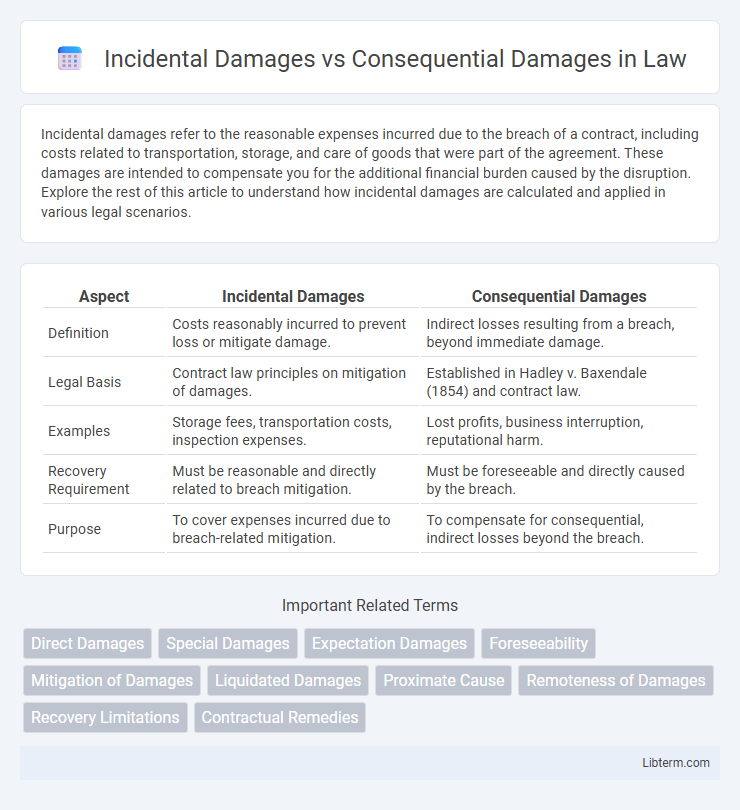Incidental damages refer to the reasonable expenses incurred due to the breach of a contract, including costs related to transportation, storage, and care of goods that were part of the agreement. These damages are intended to compensate you for the additional financial burden caused by the disruption. Explore the rest of this article to understand how incidental damages are calculated and applied in various legal scenarios.
Table of Comparison
| Aspect | Incidental Damages | Consequential Damages |
|---|---|---|
| Definition | Costs reasonably incurred to prevent loss or mitigate damage. | Indirect losses resulting from a breach, beyond immediate damage. |
| Legal Basis | Contract law principles on mitigation of damages. | Established in Hadley v. Baxendale (1854) and contract law. |
| Examples | Storage fees, transportation costs, inspection expenses. | Lost profits, business interruption, reputational harm. |
| Recovery Requirement | Must be reasonable and directly related to breach mitigation. | Must be foreseeable and directly caused by the breach. |
| Purpose | To cover expenses incurred due to breach-related mitigation. | To compensate for consequential, indirect losses beyond the breach. |
Understanding Incidental Damages
Incidental damages refer to the reasonable expenses incurred to prevent further loss or to mitigate damages resulting from a breach of contract, such as costs for storing or transporting goods. These damages are directly related to the immediate actions taken after the breach and are recoverable as part of compensatory relief. Understanding incidental damages is crucial because they differ from consequential damages, which cover indirect losses like lost profits and require proof of foreseeability and causation.
Defining Consequential Damages
Consequential damages refer to losses that do not directly result from a breach of contract but occur as a foreseeable consequence of the breach, impacting the injured party's business or profits. These damages extend beyond the immediate scope of the contract and often include lost revenue, harm to reputation, and other indirect financial harms. Courts typically require that the consequential damages were foreseeable and directly linked to the breach at the time the contract was formed for recovery to be granted.
Key Differences Between Incidental and Consequential Damages
Incidental damages refer to reasonable expenses incurred to prevent further loss or to mitigate damages directly resulting from a breach of contract, such as transportation or storage costs. Consequential damages encompass losses that are not directly caused by the breach but occur as a foreseeable result, including lost profits or business interruptions. The key difference lies in incidental damages covering immediate, necessary costs, while consequential damages address broader, indirect impacts stemming from the breach.
Legal Framework: Contract Law Basics
Incidental damages refer to reasonable expenses incurred to prevent further loss or to minimize damages after a breach of contract, such as costs for inspection, transportation, or storage of goods. Consequential damages, also known as special damages, cover losses that do not flow directly from the breach but arise as a foreseeable result, like lost profits or reputational harm. Under the Uniform Commercial Code (UCC) and common law contract principles, recovery of consequential damages typically requires proof that the breaching party had reason to foresee such losses at the time of contracting.
Common Examples of Incidental Damages
Common examples of incidental damages include reasonable expenses incurred to mitigate a breach of contract, such as costs for storing or shipping goods after a seller's failure to deliver on time. These damages cover expenses directly related to handling or preserving goods affected by the breach, like inspection fees or transportation costs. Unlike consequential damages, incidental damages are typically limited to the immediate, out-of-pocket costs arising from the breach.
Common Examples of Consequential Damages
Consequential damages commonly include lost profits due to business interruption, damage to other property caused by a faulty product, and additional costs incurred from delayed delivery of goods. These damages arise indirectly from a breach of contract and are foreseeable losses that result from specific circumstances of the injured party. Unlike incidental damages, which cover direct expenses like inspection or transportation costs, consequential damages reflect broader financial impacts beyond immediate repair or replacement.
Proving Incidental vs Consequential Damages
Proving incidental damages requires demonstrating actual, reasonable expenses incurred directly from mitigating loss, such as transportation or storage costs tied to a breach. Consequential damages demand evidence of foreseeable indirect losses caused by the breach, including lost profits or business interruptions, supported by clear causation and foreseeability at contract formation. Detailed documentation, expert testimony, and clear linkage between the breach and damages are critical to differentiate and substantiate incidental versus consequential claims in legal disputes.
Limiting Liability in Contracts
Limiting liability in contracts requires a clear distinction between incidental damages, which cover reasonable expenses directly related to a breach, and consequential damages, which involve indirect losses such as lost profits or reputational harm. Contractual clauses often cap or exclude consequential damages due to their unpredictable and potentially extensive financial impact. Precise drafting ensures enforceability by defining the scope of damages and allocating risk, thereby protecting parties from excessive liability exposure.
Court Interpretations and Case Law
Court interpretations distinguish incidental damages as reasonable expenses incurred to prevent further loss or to mitigate damages, such as transportation or storage costs, often seen in cases like Hadley v. Baxendale (1854). Consequential damages refer to losses that arise indirectly from a breach, including lost profits or harm to third parties, with courts assessing foreseeability and causal connection as established in landmark rulings like Victoria Laundry (Windsor) Ltd v. Newman Industries Ltd. Judicial analysis frequently hinges on contract terms and the foreseeability principle, influencing award limits and recovery scope in commercial litigation.
Best Practices for Managing Contractual Damages
Clearly defining incidental and consequential damages within contracts minimizes disputes and ensures proper risk allocation. Best practices include specifying the scope and limits of each damage type, incorporating liquidated damages clauses, and requiring prompt notification of damages to facilitate timely resolution. Employing thorough documentation and legal review before contract execution strengthens enforceability and clarity in damage claims.
Incidental Damages Infographic

 libterm.com
libterm.com